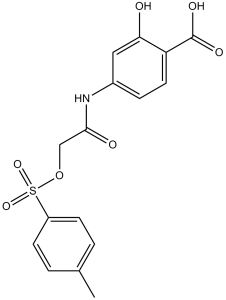S3I-201 (NSC 74859)
This product is for research use only, not for human use. We do not sell to patients.

For small sizes, please check our retail website as below: www.invivochem.com
| Size | Price | Stock |
|---|---|---|
| 250mg | $580 | Check With Us |
| 500mg | $950 | Check With Us |
| 1g | $1425 | Check With Us |
Cat #: V1378 CAS #: 501919-59-1 Purity ≥ 98%
Description: S3I-201 (also called S3I201; NSC74859; S3I 201; NSC-74859) is a cell permeable and selective Stat3 inhibitor with potential anticancer activity.
Top Publications Citing Invivochem Products
Publications Citing InvivoChem Products
Product Promise

- Physicochemical and Storage Information
- Protocol
- Related Biological Data
- Stock Solution Preparation
- Quality Control Documentation
| Molecular Weight (MW) | 365.36 |
|---|---|
| Molecular Formula | C16H15NO7S |
| CAS No. | 501919-59-1 |
| Storage | -20℃ for 3 years in powder formr |
| -80℃ for 2 years in solvent | |
| Solubility In Vitro | DMSO: 73 mg/mL (199.8 mM)r |
| Water: <1 mg/mLr | |
| Ethanol: <1 mg/mL | |
| Solubility In Vivo | 5% DMSO, 95% PEG 300 : 15 mg/mL |
| Synonyms | NSC 7485; S3I-201; NSC74859; S3I 20; NSC-74859; S3I201 |
| Protocol | In Vitro | NSC 74859 (S3I-201) preferentially inhibits Stat3 DNA-binding activity over that of Stat1 (IC50 values, Stat3•Stat3, 86±33 μM; Stat1•Stat3, 160±43 μM; and Stat1•Stat1, >300 μM) and inhibits that of Stat5 with IC50 of 166±17 μM). NSC 74859 significantly reduces viable cell numbers and inhibits growth of transformed mouse fibroblasts NIH 3T3/v-Src and breast carcinoma cell lines (MDA-MB-231, MDA-MB-435, and MDA-MB-468). At 30-100 μM, NSC 74859 induces significant apoptosis in the representative human breast carcinoma cell line MDA-MB-435 and NIH 3T3/v-Src, both of which harbor constitutively active Stat3. The breast carcinoma MDA-MB-435 cell line is more sensitive to 30 μM NSC 74859. By contrast, the human breast cancer MDA-MB-453 cells and the normal mouse fibroblasts (NIH 3T3), which do not contain abnormal Stat3 activity, are less sensitive to NSC 74859 at 100 μM or less. At 300 μM or higher, NSC 74859 induced general, nonspecific cytotoxicity independent of Stat3 activation status[1]. Huh-7 cells do not express β2SP or TBGFR2 and are sensitive to STAT3 inhibition, with an IC50 of 100 μM for NSC 74859, regardless of CD133+ status. The IC50 of NSC 74859 is 150 μM for Huh-7 and SNU-398 cells, 15 μM for SNU-475 cells and 200 μM for SNU-182 cells. NSC 74859 inhibits breast carcinoma MDA-MB-435, MDA-MB-453 and MDA-MB-231 cell lines with an IC50 close to 100 μM. |
|---|---|---|
| In Vivo | Human breast (MDA-MB-231) tumor-bearing mice are given an i.v. injection of NSC 74859 (S3I-201) or vehicle every 2 or every 3 days for 2 weeks, and tumor measurements are taken every 2-3 days. Compared with control (vehicle-treated) tumors, which continued to grow, human breast tumors in mice that received S3I-201 display strong growth inhibition. Continued evaluation of treated mice on termination of treatment shows no resumption of tumor growth, suggesting potentially a long-lasting effect of S3I-201 on tumor growth[1]. Compared with vehicle-treated control tumors (n=15), which continued to grow, S3I-201 treatment of somatotroph tumor xenografts (n=15) significantly attenuated tumor growth for the duration of the experiment. Tumors derived from NSC 74859-treated rats are significantly smaller than those from the untreated group (220±16 mm3 vs. 287±16 mm3, P<0.01) as early as 5 days after NSC 74859 injection. Fifteen days after treatments, the average tumor volume of NSC 74859-treated rats is 64% of that of controls (449±40 mm3 vs. 708±83 mm3, P<0.01). Rats are sacrificed and tumors are harvested 15 days after treatment initiation. The average tumor weight of NSC 74859-treated rats is 78±8 mg, while tumors derived from control rats weighed 114±13 mg (32% reduction; P<0.05). |
These protocols are for reference only. InvivoChem does not
independently validate these methods.
| Solvent volume to be added | Mass (the weight of a compound) | |||
|---|---|---|---|---|
| Mother liquor concentration | 1mg | 5mg | 10mg | 20mg |
| 1mM | 2.7370 mL | 13.6851 mL | 27.3703 mL | 54.7405 mL |
| 5mM | 0.5474 mL | 2.7370 mL | 5.4741 mL | 10.9481 mL |
| 10mM | 0.2737 mL | 1.3685 mL | 2.7370 mL | 5.4741 mL |
| 20mM | 0.1369 mL | 0.6843 mL | 1.3685 mL | 2.7370 mL |
The molarity calculator equation
Mass(g) = Concentration(mol/L) × Volume(L) × Molecular Weight(g/mol)
Mass
=
Concentration
×
Volume
×
Molecular Weight*
The dilution calculator equation
Concentration(start)
×
Volume(start)
=
Concentration(final)
×
Volume(final)
This equation is commonly abbreviated as: C1 V1 = C2 V2
Concentration(start)
C1
×
Volume(start)
V1
=
Concentration(final)
C2
×
Volume(final)
V2
Step One: Enter information below
Dosage mg/kg
Average weight of animals g
Dosing volume per animal µL
Number of animals
Step Two: Enter the in vivo formulation
%DMSO
+
%
+
%Tween 80
+
%ddH2O
Calculation Results:
Working concentration:
mg/ml;
Method for preparing DMSO master liquid:
mg
drug pre-dissolved in
µL
DMSO(Master liquid concentration
mg/mL)
,Please contact us first if the concentration exceeds the DMSO solubility of the batch of drug.
Method for preparing in vivo formulation:
Take
µL
DMSO master liquid, next add
µL
PEG300, mix and clarify, next add
µL
Tween 80,mix and clarify, next add
µL
ddH2O,mix and clarify.
Note:
- (1) Please be sure that the solution is clear before the addition of next solvent. Dissolution methods like vortex, ultrasound or warming and heat may be used to aid dissolving.
- (2) Be sure to add the solvent(s) in order.




































